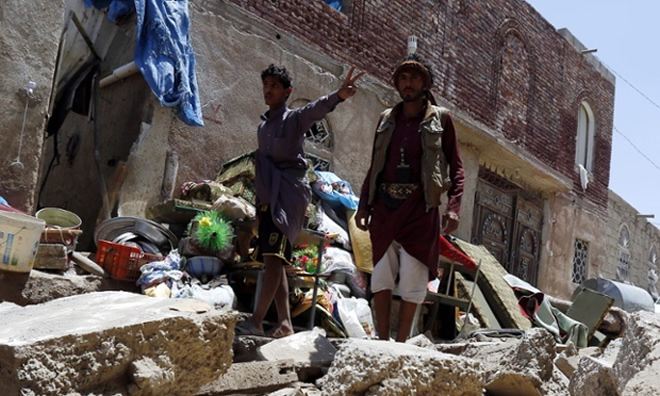
Yemenis collect their belongings after their houses were hit by an airstrike in Sana’a. Many are fleeing to neighbouring countries, threatening to overload refugee camps.

Saturday, April 11, 2015
People displaced by the civil war in Yemen are taking speedboats and ferries across the Gulf of Aden to reach neighbouring African countries where refugee camps are already stretched thin, raising fears that prolonged fighting could strain humanitarian resources.
Clashes between Houthi rebel fighters and forces loyal to the internationally recognised president Abd-Rabbu Mansour Hadi, who last month fled to Saudi Arabia, have triggered the exodus. So far, more than 600 people have been killed in the conflict.
Yemeni fisherman have been the first to flee, using their own boats to cross the Gulf of Aden to Djibouti, the closest safe haven, which can take as little as two hours to reach by speedboat. Ethiopian and Somali migrants, who had made the journey in the opposite direction, are also returning home.
Djibouti has received 4,260 migrants from Yemen, according to Chissey Mueller, Yemen project manager for the International Organisation for Migration (IOM). “If the conflict stays at this escalated pace, with the air strikes and the fighting hot in the south, it will strain on Djibouti’s humanitarian resources. Djibouti is a very, very small country and it already hosts many refugees and migrants. It will be very difficult,” said Mueller.
Somaliland, a self-declared country in northern Somalia, has received 270 migrants from Yemen. A further 389 people have arrived in Puntland, another Somali breakaway state, according to the IOM.
“There has been some movement of people fleeing Yemen to Somalia and Djibouti,” said Carlotta Wolf, a spokeswoman for the UN High Commissioner for Refugees (UNHCR). “The numbers so far are small but we are preparing for a larger influx, should it occur.”
Djibouti, Somaliland and Puntland already host tens of thousands of refugees, according to the UNHCR. Djibouti is home to about 24,000 refugees, while Somaliland hosts roughly 9,000 displaced people.
The UNHCR is preparing a refugee camp that will host new arrivals in Djibouti, which is less than 30km from Yemen, said Frédéric Van Hamme, a UNHCR spokesman based in Djibouti.
Somaliland’s foreign minister, Mohamed Yonis, said he is expecting to receive up to 2,000 Yemeni refugees and is in talks with the EU and USAid about providing assistance for them. “It will be a challenge – we have a lot of Ethiopian refugees in Somaliland, we have a lot of internally displaced people. But we hope the international community will come to the rescue,” said Yonis.
People fleeing Yemen face a 12-hour journey by sea to reach Berbera, Somaliland’s main port. Somaliland currently hosts 2,153 refugees and 6,805 asylum seekers, mainly from Ethiopia, according to the UNHCR. “The group [arriving in Somaliland] included elderly men, children and women. They claimed to flee the recent conflict in Taiz, Yemen,” Wolf said.
As part of normal migration flows, tens of thousands of Ethiopian and Somali migrants travel across the Gulf of Aden to Yemen hoping to find better economic prospects in Saudi Arabia and freedom from persecution.
With Yemen descending into full-blown civil conflict, the fate of nearly 250,000 refugees who have settled in the country – mainly from Somalia – hangs in the balance. About 1 million Ethiopian migrants also live in Yemen, according to the IOM, while UNHCR figures suggest that 330,000 Yemenis are internally displaced by previous waves of violence.
Earlier in the week, the IOM said it had evacuated 28 Ethiopian migrants to Djibouti from Yemen by sea.
“Thousands of Ethiopians are currently believed to be stranded by the fighting in Yemen and in need of evacuation. IOM Ethiopia is working with the Ethiopian government and its offices in Yemen and Djibouti to evacuate the most vulnerable and provide post-arrival assistance,” the IOM said.
Links between Somali Islamist insurgency al-Shabaab and Yemen-based Al-Qaida in the Arabian Peninsula (AQAP) have raised fears that terror groups may take advantage of new migration flows. “We have a task force looking into [the effect of Yemeni migrants on Somaliland] and we are putting contingency planning in place,” Yonis said.
“While we welcome [refugees] of course, we have to remain vigilant and ensure there are no radical elements in the groups coming in and we’re doing a proper screening process on the groups coming in.”